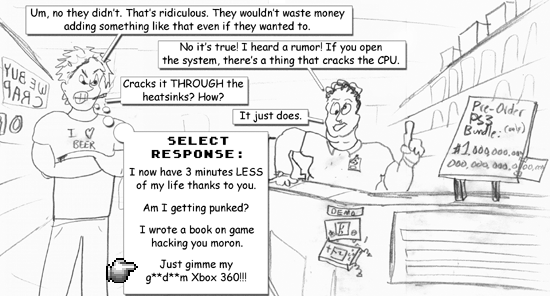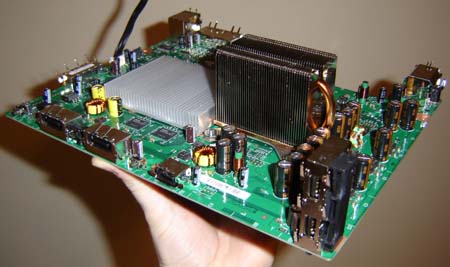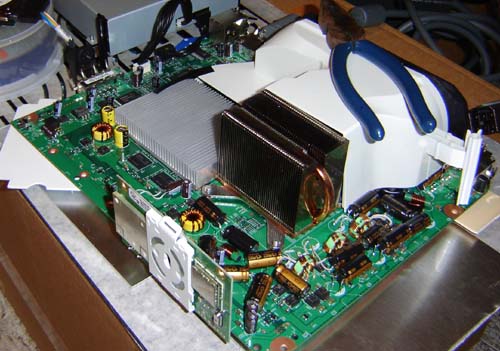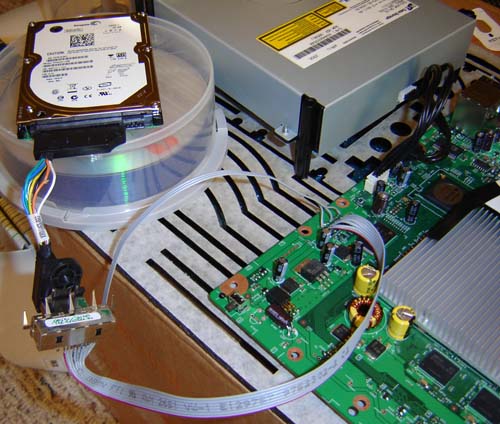|
|
|||||
A friend of mine asked back in May "Can you build an Xbox 360 laptop?" And I responded "Sure, can you pay for it?" He agreed, and thus I set forth on what was surely to be my most complex and insanely ridiculous videogame project yet. (I say videogame project as I highly doubt I'll ever manage anything as complex as Port Washington again, though at times this project sucked my will to live about as much) With my first batch of "venture capital" in hand I ran off to the nearby store to get myself an Xbox 360 Super Package, or whatever the $400 version is called. While I won't mention the game store I stopped at by name, I will recreate the amazing conversation I had with one of their employees...
Sadly, only my side of this conversation is exaggerated.
Several years passed by, but I finally had the Xbox 360 free and clear. I hightailed it out of there, vowing never to return. Now I could get to work! (I hope the CHIP SMASHERS don't get me) Please note, this story was assembled as I worked on the device (as opposed to afterwards like I usually do) so sometimes it will branch off in different directions and have the topic shift rapidly. However, this accurately represents the workflow, more so than other articles I've written. Dateline: First Week of June '06 After FINALLY snagging the 360 I brought it home and immediately tore it apart. I didn't even test it out - I mean why bother? I've played quite a bit of 360 already, I was more interested in the guts of the thing. (I can always eat rat meat later)
Using a handy "how-to" on the Internet I had the thing taken apart in under 10 minutes. Half the time was looking for my lost Torx bits, until I realized there were some in my precious ratcheting screwdriver. Anyway, I looked over the motherboard to see what could be "flattened" to make the thing thinner (Heat sinks didn't count as I was planning to replace them with water-cooling) The obvious choice were the numerous large electrolytic caps. (black cylinders in above photo) As with many systems I've worked on, I de-soldered them all and reattached them laying flat. In most cases I had to extend their leads to make this work. Oh well.
Above you can see the board with the flattened caps. (That's the cool, hip, geek slang term for capacitor you know) There are also several wound torrid coils on the board (yellowish things to the lower right of the tall heat sink) that would be a real pain to move so I left those standing as "the highest things on the motherboard" Still it's not too bad, with the exception of the power port on the back nothing is more than 1/2" above the motherboard now. You might also noticed I've also removed the front USB and memory card slots at this point. The front side USB connections will go to the keyboard / extra USB ports while the rear port will be used with the Wi-Fi module.
In my tentative system layout the hard drive is moved a good ways from the original connector. Since the stubby cord inside the Hard Drive Enclosure is, well, stubby, I had to see if extending the SATA cable was possible. The least destructive way of doing this was to de-solder the connector from the motherboard and extended between them, as seen above. The idea of extending the SATA cable with old parallel IDE cable was a bit humorous, to me at least. Naturally I didn't copy every connection, since +5 and Ground are on there 3 times each. Why have excessive cabling? I did a test boot and watched one of the videos off the drive (you know a system is quality when it comes pre-loaded with James Cameron) I then played games for about an hour. Nothing exploded or melted a hole through my floor so I think we're good. I now feel OK to extend the DVD drive's SATA if required - the existing cable is about 3" long, but most replacement cables are 2' minimum. I was worried when I read SATA doesn't use TTL, but apparently it doesn't exactly use magic either, so it's still hackable. In the final version I'll attach the gray ribbon cables directly to the colored wires coming off the hard drive's connector, skipping the Microsoft plugs altogether. This ends Phase 1 of the project. Next step - water cooling! The parts are on the way, I'm a bit worried about the pump though. It's the smallest we could find, but it's still big (for a project like this) Depending on its size I might have to build a new DVD drive loading system, just to make everything fit. Also in the experimental realm is the custom radiator I plan to build. The plan is it'll fit in the space at the rear of the motherboard where the fans were, then external fans pull air through it. The idea is to put tubing in all available empty space to increase the volume. Some of the tubing might even be exposed around the case for decoration and cool backlighting. But will it run cold (I mean NOT HOT) enough? One consolation I have for this step is the massive heat given off by the 'sinks in the standard configuration. Sure they've got that fan that sort of pulls air past them, but still the GPU especially gets REALLY hot. Lacking an infrared thermometer I can only compare it to things. Hm... How about when you microwave a bowl of something and the bowl's so hot you can only carry it for about 1 second before setting it down? Yeah, that's about right. (Don't ask me what that is in Celsius) The worst thing is that's what it's like running open air as shown above, I can only imagine how hot it gets in that case. Maybe Microsoft could sell a coffee warmer attachment or something... The next thrilling
section continues!
|
|||||






